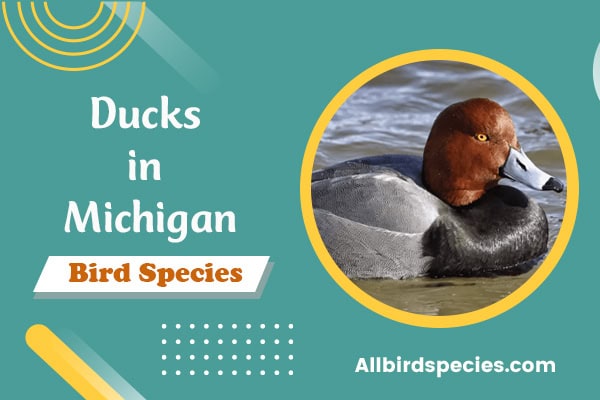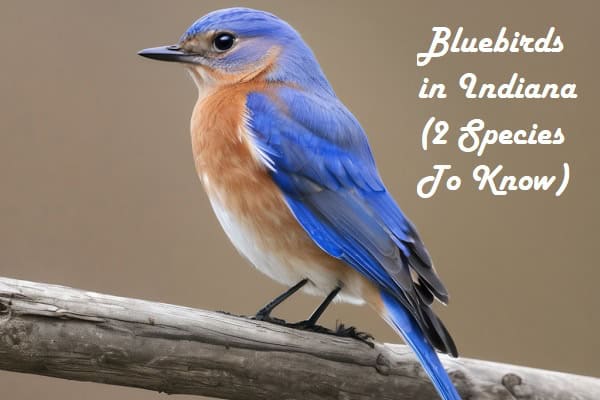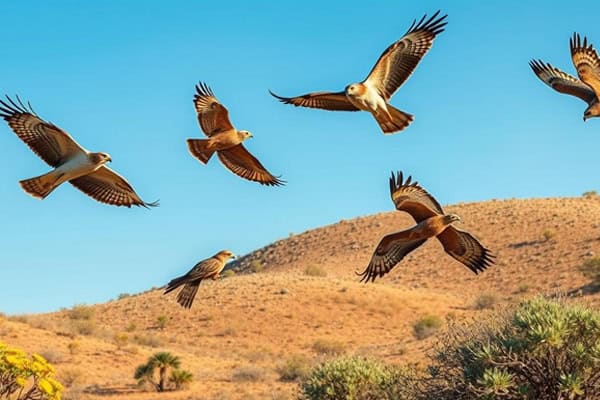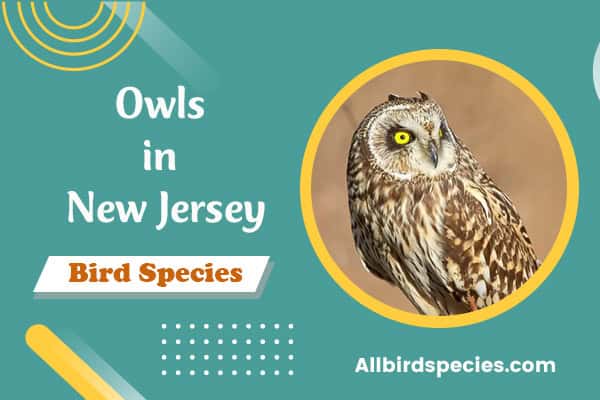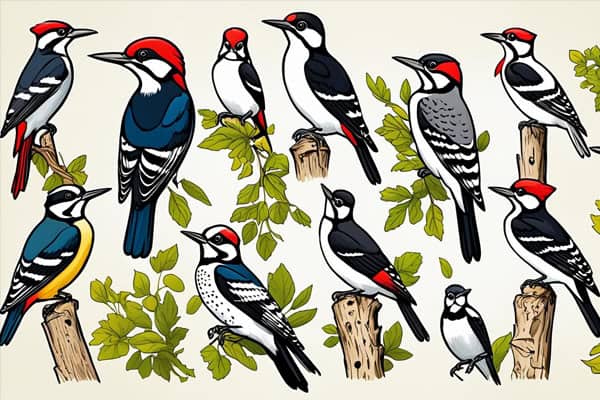23 Types of Ducks in Michigan (With Pictures)
Did you know Michigan is home to over 23 different types of ducks? Its vast wetlands and rich biodiversity make it a key spot for these birds. It’s perfect for birdwatchers and nature lovers. Let’s explore the unique traits and habitats of these ducks in Michigan.
From the familiar Mallard to the elegant Northern Pintail, each duck is vital to Michigan’s wildlife. We’ll take you through the diverse places where they live. You’ll learn about the best spots to see them and gain a deeper appreciation for these amazing birds.
Common Ducks Found in Michigan
- Mallard
- Northern Pintail
- Northern Shoveler
- American Wigeon
- Wood Duck
- Blue-winged Teal
- Gadwall
- Green-winged Teal
- American Black Duck
- Ring-necked Duck
1. Mallard Duck
- Scientific name: Anas platyrhynchos
- Life span: 5-10 years
- Size: 50-65 cm
- Weight: 700-1600 g
- Wingspan: 81-98 cm
The Mallard duck, known scientifically as Anas platyrhynchos, is a well-known common duck species. It’s easy to spot because of the male’s shiny green head and the female’s brown feathers. These ducks live in many places, from city parks to wetlands in the countryside.

They build their nests near water, often on the ground in tall grass. This keeps their eggs safe from predators. Mallards eat plants, insects, and small fish, making them a common sight at lakes and ponds.
Efforts to protect their homes show how important Mallard ducks are to our environment. They are resilient and adapt well, showing their value in both nature and cities across North America.
2. Northern Pintail
- Scientific name: Anas acuta
- Life span: 10-15 years
- Size: 56-66 cm
- Weight: 450-1150 g
- Wingspan: 80-95 cm
The Northern Pintail (Anas acuta) is a standout among migratory ducks. It’s known for its long neck and sleek body. Birdwatchers and nature lovers can easily spot it. The male’s chocolate-brown head and white neck stripe during the breeding season make it easy to identify.

These birds live in the northern parts of North America during breeding season. They prefer wetlands and grasslands. When winter comes, they migrate to warmer areas.
They look for specific habitats for survival. These places give them what they need to eat and nest.
The Northern Pintail eats aquatic plants, seeds, and small invertebrates. This diet helps them stay energized for their long migrations. Watching them feed shows how they prefer shallow waters for foraging.
Despite their beauty, Northern Pintails face threats like habitat loss and hunting. Restoring wetlands is key to helping their populations. Conservation efforts aim to protect their homes and teach sustainable living. This is crucial for keeping these elegant birds safe for the future.
| Characteristic | Details |
|---|---|
| Scientific Name | Anas acuta |
| Breeding Habitat | Wetlands and Grasslands in northern North America |
| Migration | Winter migration to warmer regions |
| Diet | Aquatic plants, seeds, small invertebrates |
| Challenges | Habitat degradation, hunting |
| Conservation Focus | Wetland restoration, sustainable practices |
Ducks in other Regions:
3. Northern Shoveler
- Scientific name: Spatula clypeata
- Life span: 10-15 years
- Size: 43-53 cm
- Weight: 400-1100 g
- Wingspan: 74-86 cm
The Northern Shoveler (Spatula clypeata) is known for its big bill. This big bill helps it filter small invertebrates and seeds from the water. It’s a special way of eating that makes it stand out.

This bird is easy to spot because of its bright colors. Males have green heads, white chests, and reddish-brown sides. Females look more mottled brown. Their big bills and how they swim make them stand out.
Northern Shovelers like to nest in marshy areas. These places have lots of grasses and reeds where they can hide their eggs. They help control aquatic plants and are food for many animals. We need to protect their wetland homes to keep them safe.
4. American Wigeon
- Scientific name: Mareca americana
- Life span: 12-15 years
- Size: 42-59 cm
- Weight: 600-1200 g
- Wingspan: 76-91 cm
The American Wigeon, known as Mareca americana, is a standout among waterfowl for its unique sounds and looks. Birdwatchers and nature lovers find joy in watching these whistling ducks. They appreciate the special traits that make these ducks easy to spot and their interesting behaviors and role in nature.
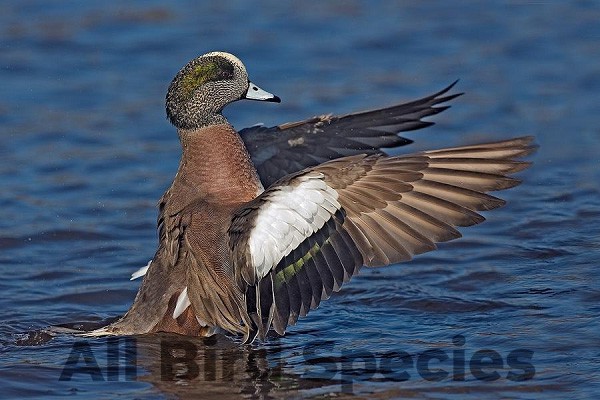
Identification Features
Spotting the American Wigeon is easier with these key features:
- Males have a bright green patch on their heads, a cream-colored crown, and a subtle grayish body.
- Females are brownish and less vibrant, making the male’s bright look stand out.
- Both males and females have a white stripe on their wings that shows when they fly.
These ducks eat aquatic plants and small invertebrates, showing how they adapt to their environment. They nest in dense vegetation near water, showing their need for wetlands for breeding and finding food. Keeping their habitats safe is crucial for the American Wigeon’s survival and the health of their ecosystems.
5. Wood Duck
- Scientific name: Aix sponsa
- Life span: 5-10 years
- Size: 48-54 cm
- Weight: 454-862 g
- Wingspan: 66-73 cm
The Wood Ducks (Aix sponsa) is a unique and beautiful duck in Michigan. It is known for its stunning plumage. These ducks like to nest in tree cavities near water. This makes them different from other waterfowl, as they choose safe, high places for their nests.
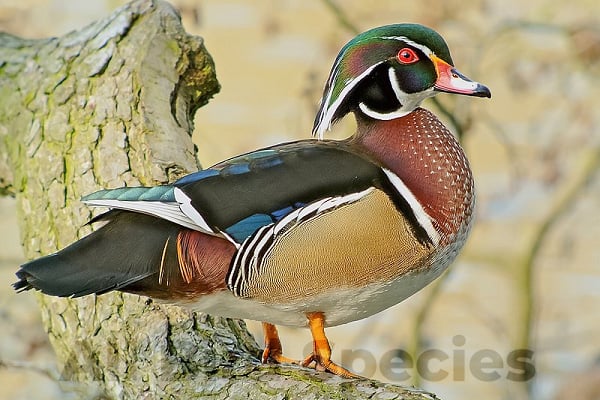
Wood Ducks eat a mix of seeds, fruits, and insects. They play a big role in their ecosystem. By spreading seeds, they help keep wetlands healthy and diverse. They also control insect populations, which is important for the balance in their habitats.
Conservation efforts have helped increase Wood Duck numbers. Laws and habitat restoration have made a big difference. Now, we can enjoy these beautiful birds more than ever. Learning about their needs shows us why we must protect their homes.
6. Blue-winged Teal
- Scientific name: Spatula discors
- Life span: 5-10 years
- Size: 40-47 cm
- Weight: 280-420 g
- Wingspan: 58-63 cm
The Blue-winged Teal (Spatula discors) is a small, beautiful ducks of Michigan. It’s known for its bright blue wing patch. These birds are found in Michigan’s wetlands, showing off their swimming skills. They migrate south in the fall and return in spring to breed in their favorite spots.
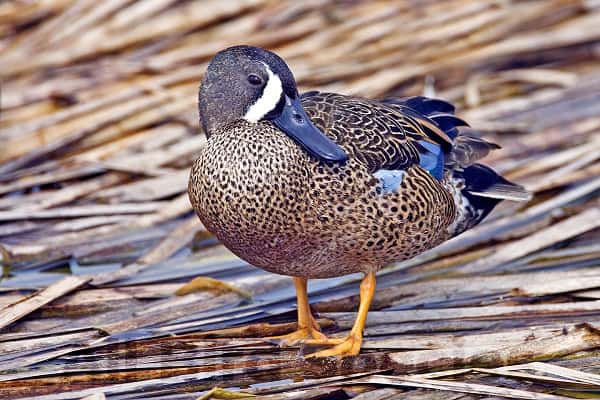
It’s easy to spot the Blue-winged Teal for those who love waterfowl. Males have a rich chestnut head and a blue wing patch. Females are less colorful, helping them hide from predators. They like to nest near water with lots of plants for their babies.
These ducks eat aquatic plants, seeds, and small bugs. Their eating habits help keep their habitats healthy. We work to protect their homes in the wetlands so they can keep living in our natural world.
7. Gadwall
- Scientific name: Mareca strepera
- Life span: 5-10 years
- Size: 46-56 cm
- Weight: 800-1,350 g
- Wingspan: 81-95 cm
The Gadwall ducks of Michigan, known scientifically as Mareca strepera, have a quiet beauty. It’s found all over North America but often goes unnoticed because of its dull feathers. Yet, its beauty shines through in its detailed patterns and elegant way of moving.
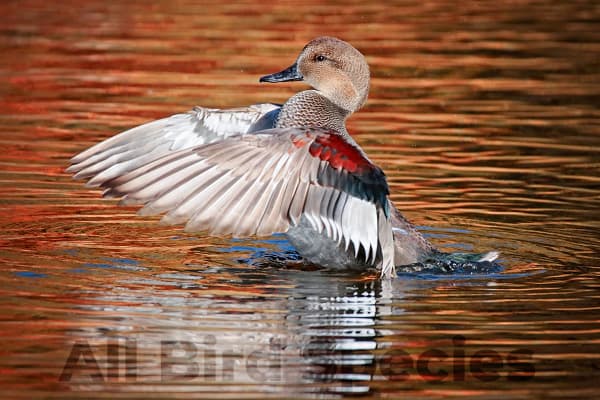
Gadwalls are dabbling ducks that eat near the water’s edge. They enjoy a mix of aquatic plants, seeds, and small animals, keeping the ecosystem healthy. For laying eggs, they pick spots with lots of plants near water, keeping their babies safe.
Working to protect wetlands helps Gadwalls survive. Keeping these areas safe lets us enjoy a world full of different birds, including this amazing one. By learning about Gadwalls, like their size and how they look, we see their importance and beauty in nature.
| Feature | Description |
|---|---|
| Species Name | Mareca strepera |
| Coloration | Grayish-brown with a distinctive black rear end |
| Size | Medium-sized duck, approximately 19-23 inches in length |
| Habitat | Freshwater marshes, lakes, and ponds |
| Diet | Variety of aquatic plants, seeds, and invertebrates |
8. Green-winged Teal
- Scientific name: Anas crecca
- Life span: 5-10 years
- Size: 33-38 cm
- Weight: 150-400 g
- Wingspan: 53-59 cm
The Green-winged Teal is the smallest duck in North America. It can be found in marshes and ponds across the country. The males have a chestnut-colored head with a green patch around the eyes, while the females are a modest brown.

These ducks of Machigan prefer to nest in dense grasses or shrubs near water. The female carefully builds a ground nest, hiding it with plants and lining it with soft down to protect her eggs.
Green-winged Teals are agile and resourceful, feeding on a mix of aquatic plants, seeds, and small water creatures. Their diet shows how well they adapt to seasonal changes and available food, highlighting the need for healthy wetlands for their survival.
9. American Black Duck
- Scientific name: Anas rubripes
- Life span: 5-10 years
- Size: 54-63 cm
- Weight: 727-1,380 g
- Wingspan: 91-102 cm
The American Black Ducks of Michigan prefers the woodlands and marshes of the eastern U.S. It has darker feathers than the Mallard, with both males and females sharing a sooty-brown color that helps them blend into their surroundings.

In quiet, dense marsh vegetation or on a woodland floor, the American Black Duck carefully builds its nest. The female chooses a hidden spot, making her nest from plants and lining it with soft down. This hidden place is where she lays and protects her eggs, showing her strong dedication to her young.
The American Black Duck forages in shallow waters, usually during dawn or dusk. It eats a variety of aquatic plants, seeds, and small water creatures. Their diet highlights the rich resources of their wetland habitats, showing how important these ecosystems are for their survival.
10. Ring-necked Duck
- Scientific name: Aythya collaris
- Life span: 5-10 years
- Size: 39-46 cm
- Weight: 680-1,360 g
- Wingspan: 63-76 cm
Despite its name, the Ring-necked Duck is more easily recognized by the bold white ring on its bill and its angular head shape. It can be found in lakes and ponds across the U.S.

The Ring-necked Duck, a sleek diving bird with a subtle neckband, chooses quiet wetlands for its nests. The female builds her nest in thick vegetation near water, using plants and soft down to create a safe and warm place for her eggs, showing her dedication to their safety.
The Ring-necked Duck mainly eats aquatic plants, seeds, and small water creatures, adapting well to freshwater habitats. This varied diet helps keep wetland ecosystems healthy, with these ducks playing an important role in the aquatic food chain.
11. Redhead
- Scientific name: Aythya americana
- Life span: 10-15 years
- Size: 42-49 cm
- Weight: 850-1,600 g
- Wingspan: 76-84 cm
The Redhead, a duck found in freshwater marshes across North America, is known for the bright red head of the males. Both males and females have a blue bill and a sleek appearance.
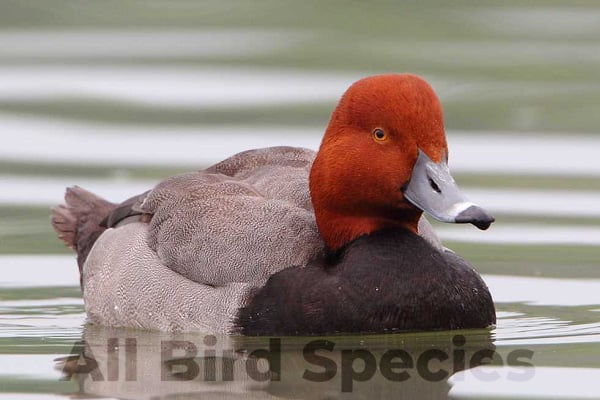
Redheads often nest in marshes, where the female builds a floating nest using reeds and grasses. She lines it with soft down, creating a safe and warm spot for her eggs, showing how well these ducks have adapted to wetland life.
Redheads eat a mix of aquatic plants and small water creatures, demonstrating their ability to adapt to what their environment offers. This varied diet helps them thrive in different wetland areas, making them an important part of the aquatic food chain.
12. Bufflehead
- Scientific name: Bucephala albeola
- Life span: 12-15 years
- Size: 32-40 cm
- Weight: 270-550 g
- Wingspan: 46-54 cm
The Bufflehead is a small, buoyant duck found in North America’s lakes and sheltered bays. Males have a large white patch on their dark heads, while females have a more muted color.

Buffleheads are lively divers that nest in tree cavities near water. The female lines these cavities with soft down, creating a safe and warm place for her young. Their need for tree cavities shows the importance of preserving woodlands for their survival.
Buffleheads mainly eat crustaceans and insects by diving underwater, showing off their specialized foraging skills. This diet helps keep their aquatic habitats balanced, highlighting how different species depend on each other within ecosystems.
13. Ruddy Duck
- Scientific name: Oxyura jamaicensis
- Life span: 6-8 years
- Size: 36-43 cm
- Weight: 430-790 g
- Wingspan: 61-74 cm
The Ruddy Duck lives in marshes and ponds and is known for its stiff tail and bright blue bill during the breeding season. Males have a striking chestnut-colored body, while females have a more modest brown.
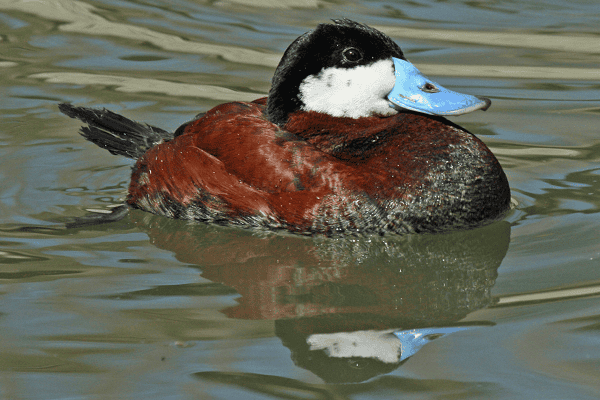
Ruddy Ducks of Michigan build their nests in dense marsh vegetation, floating them on the water to stay safe from predators. The female skillfully weaves and hides her nest, showing how well they’ve adapted to living in wetlands.
Ruddy Ducks primarily eat seeds and roots of aquatic plants, along with small water creatures. Their diet helps spread plant seeds, contributing to the health and diversity of wetland ecosystems.
14. Canvasback
- Scientific name: Aythya valisineria
- Life span: 10-15 years
- Size: 48-56 cm
- Weight: 1,270-1,800 g
- Wingspan: 84-89 cm
The Canvasback, found in northern U.S. lakes and coastal bays, has a distinctive sloping profile. Males have white bodies with black chests, while females are a softer gray.
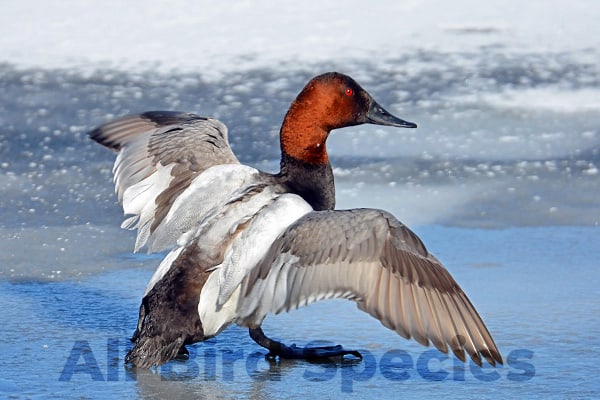
Canvasbacks prefer marshlands with dense reeds and grasses for nesting. The female carefully builds her nest on floating platforms of vegetation in shallow water, which helps protect the nest from predators and harsh weather.
Canvasbacks are skilled divers, mainly eating aquatic tubers, roots, and bulbs from underwater plants, along with snails and insects. This high-energy diet supports their long migrations and breeding, showing how closely they rely on healthy underwater plant communities.
15. Greater Scaup
- Scientific name: Aythya marila
- Life span: 10-20 years
- Size: 41-51 cm
- Weight: 900-1,600 g
- Wingspan: 81-87 cm
The Greater Scaup, found in northern U.S. waters, is a diving duck. Males have glossy green-black heads, while females have a more understated brown.
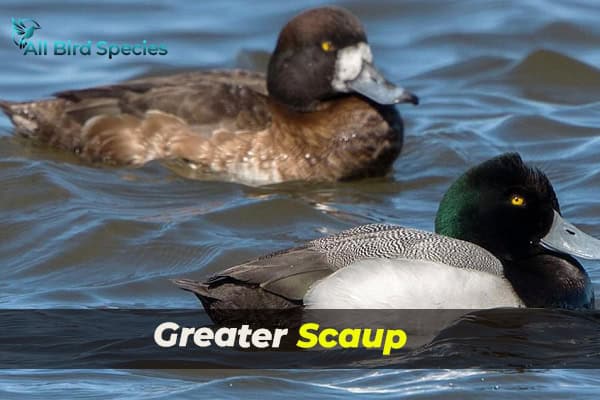
Greater Scaups nest on the ground near water. The female creates a cozy nest by lining a shallow depression with down, keeping her eggs warm in the cold environments they live in.
Greater Scaups prefer shellfish, diving in deeper waters than most ducks to find their food. This diet helps control aquatic invertebrate populations, playing a key role in maintaining healthy marine ecosystems.
Conservation efforts for the Greater Scaup focus on tackling issues like habitat loss and pollution, especially in their Arctic breeding grounds and wintering areas along coasts. Protecting these habitats is essential for their survival, highlighting the global importance of bird conservation.
16. Lesser Scaup
- Scientific name: Aythya affinis
- Life span: 12-15 years
- Size: 38-48 cm
- Weight: 400-1000 g
- Wingspan: 64-74 cm
The Lesser Scaup Ducks in Michigan, like its larger relative, live in similar habitats but are more common in the U.S. Males have dark heads and bright eyes, while females are brown.

Lesser Scaups choose secluded spots near water to nest. The female builds a hidden nest among vegetation, carefully lining it with down to protect her eggs from predators and the weather.
The Lesser Scaup has a varied diet, eating both aquatic invertebrates and plant material. This adaptability helps them thrive in different wetland habitats, making them important contributors to aquatic ecosystems as both predators and herbivores.
17. Hooded Merganser
- Scientific name: Lophodytes cucullatus
- Life span: 6-12 years
- Size: 40-49 cm
- Weight: 400-700 g
- Wingspan: 63-76 cm
The Hooded Merganser, easily recognized by its distinctive crest, is found in wooded ponds across the U.S. Males have a striking white crest, while females have a more subdued tawny one.

Hooded Mergansers prefer to nest in tree cavities near water, choosing these secure and secluded spots for their eggs. The female lines the cavity with her own down, creating a warm and protected environment.
As skilled divers, Hooded Mergansers specialize in catching small fish and aquatic invertebrates. Their diet shows their role as predators in aquatic ecosystems, helping to maintain the balance of species and the health of their habitats.
18. Red-breasted Merganser
- Scientific name: Mergus serrator
- Life span: 9-14 years
- Size: 54-62 cm
- Weight: 700-1,600 g
- Wingspan: 66-81 cm
The Red-breasted Merganser prefers coastal waters and is known for its thin, spiky crest. Males have a dark head and red chest, while females are a more uniform gray-brown.
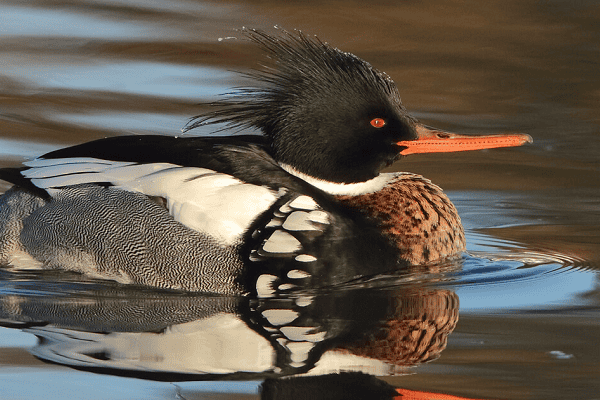
Red-breasted Mergansers nest on the ground near water, usually in sheltered spots among vegetation. The female builds her nest from plant material and lines it down to keep her eggs warm and hidden, showing her strong protective instincts.
These ducks are excellent hunters, diving to catch small fish and aquatic invertebrates in Michigan. Their diet helps keep fish populations and aquatic ecosystems healthy, playing a key role in regulating their environment.
19. Black Scoter
- Scientific name: Melanitta americana
- Life span: 10-15 years
- Size: 43-54 cm
- Weight: 30.4-38.8 oz
- Wingspan: 79-91 cm
The Black Scoter is a sea duck usually found off the coasts. Males are all black with a distinctive bill knob, while females are a dusky brown.
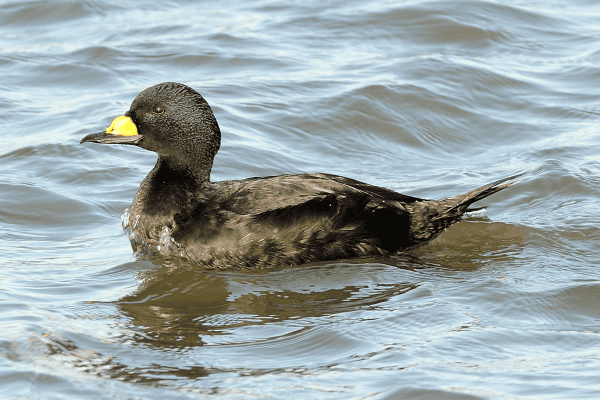
Black Scotts prefer nesting on the ground in dense vegetation near water in their northern breeding areas. The female makes a simple nest lined with down, providing warmth and hiding her eggs, which suits their cold, northern habitats.
These ducks eat mainly mollusks and crustaceans, showing their strong connection to marine environments. Their diet highlights the need for clean, productive coastal waters to ensure their survival, emphasizing their role in maintaining healthy marine ecosystems.
20. Surf Scoter
- Scientific name: Melanitta perspicillata
- Life span: 10-20 years
- Size: 45-54 cm
- Weight: 710-1,980 g
- Wingspan: 76-91 cm
The Surf Scoter is commonly found along North America’s coasts and is known for its striking black plumage. Males have colorful, bulbous bills, while females are more subdued brown but have a similar distinctive bill shape.

Surf Scoters nest on the ground in secluded boreal forests, away from their coastal wintering areas. The female builds a hidden nest among dense brush, showing her strong commitment to keeping her eggs safe.
They mainly eat marine invertebrates, especially mollusks, highlighting their connection to coastal and marine environments. Their feeding habits help maintain the health of marine ecosystems, showing how sea ducks play a role in nutrient cycling and energy flow.
21. Common Goldeneye
- Scientific name: Bucephala clangula
- Life span: 6-12 years
- Size: 40-51 cm
- Weight: 800-1,550 g
- Wingspan: 66-81 cm
The Common Goldeneye lives in northern lakes and rivers. Males are striking with glossy green heads and white bodies, while females are rich chocolate brown.
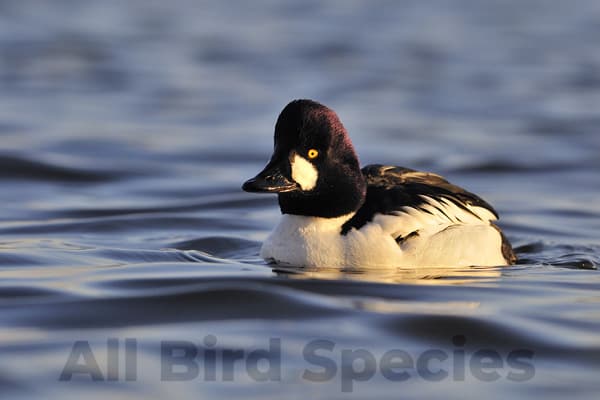
Common Goldeneyes ducks of Michigan have a unique nesting habit, using tree cavities or nest boxes near water. The female lines the nest down to create a warm, cozy spot for her eggs. This behavior shows how important mature forests near wetlands are for their breeding.
As skilled divers, Common Goldeneyes eat a diet of aquatic invertebrates and small fish. Their feeding helps control prey populations and keeps aquatic ecosystems healthy, showing their key role in nature’s balance.
Conservation efforts for the Common Goldeneye focus on providing suitable nesting habitats through nest boxes and protecting forested wetlands. These actions help address the loss of natural nesting sites and support the species’ survival in its native areas.
22. Cinnamon Teal
- Scientific name: Spatula cyanoptera
- Life span: 7-10 years
- Size: 15-16 in
- Weight: 12-15 oz
- Wingspan: 24-26 in
The Cinnamon Teal, found only in the western marshes of the U.S., has a striking reddish-brown plumage for males, while females are a more muted mottled brown.
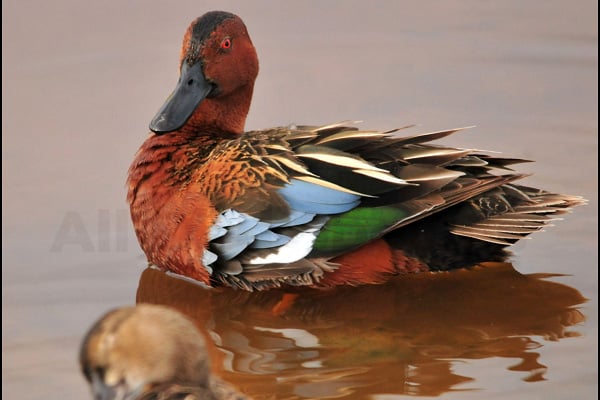
Cinnamon teal ducks of Michigan are secretive nesters, placing their nests on the ground among dense vegetation near water. The female builds a cozy bowl-shaped nest lined with down to keep her eggs safe from predators and the weather.
Their diet includes a mix of aquatic invertebrates and plant matter, showing their ability to adapt to available resources. This diet highlights the need for healthy, diverse wetlands to support their survival as they forage in shallow waters.
Conservation efforts for the Cinnamon Teal focus on preserving and restoring wetland habitats. Ensuring clean water sources and protecting nesting sites are key to their well-being, reflecting a broader commitment to environmental care and biodiversity.
23. Common Merganser
- Scientific name: Mergus merganser
- Life span: 5-12 years
- Size: 56-64 cm
- Weight: 1.0-1.4 kg
- Wingspan: 66-76 cm
The Common Merganser is a large duck found in rivers and lakes across the U.S. Males have a sharp white and dark green look, while females are gray with a reddish head.
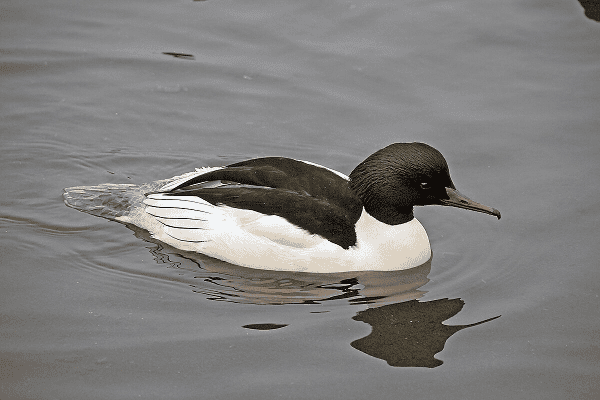
Common Mergansers like to nest in tree cavities or large nest boxes near water. The female makes a warm, down-lined nest, which helps protect her eggs from predators and flooding, showing how well they’ve adapted to life in riparian areas.
These ducks are skilled fish hunters, feeding in clear, freshwater rivers and lakes. Their hunting helps control fish populations, showing their important role as top predators in aquatic ecosystems.
Conservation efforts for the Common Merganser focus on protecting riparian habitats and ensuring clean water. Keeping these areas free from pollution and development is crucial for providing safe nesting and foraging spots, highlighting the link between water quality and wildlife health.
Ducks in Michigan are commonly found in several key areas:
- Great Lakes: The shores of the Great Lakes, particularly Lake St. Clair and Saginaw Bay, offer extensive wetlands and marshes that attract many duck species.
- State Wildlife Areas:
- Nayanquing Point State Wildlife Area: Known for its wetlands and waterfowl habitat.
- Shiawassee National Wildlife Refuge: Provides managed habitats for various duck species.
- Other Notable Spots:
- Kalamazoo River: Offers good duck-watching opportunities.
- Holland State Park: Located on Lake Michigan, providing access to waterfowl.
- Muskegon Lake: Features wetland areas that attract ducks.
For the best viewing, visit during spring and fall migrations when ducks are more abundant.
Check Our Previous Articles:
| Herons in Florida |
| Hawks in Virginia |
| Hawks in Pennsylvania |
| Birds of the African Savanna |
| Hawks in North Carolina |
Wrapping Up…
Our journey into Michigan’s duck species has shown us a world of fascinating birds. From the common Mallard to the stunning Wood Duck, each plays a key role. They help keep our wetlands and waterways healthy.
It’s crucial to protect these birds and their homes. By supporting conservation, we make sure future generations can enjoy these amazing birds. We must work together to protect Michigan’s bird life against environmental changes.

